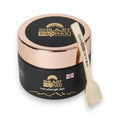Introduction
Ever wondered what makes Himalayan Shilajit such a coveted health supplement? You’re not alone. This sticky, tar-like substance has been used for centuries in Ayurvedic medicine, praised for its energy-boosting and rejuvenating properties. But with the surge in popularity comes a flood of low-quality and fake products—especially in the UK market. If you’re here, you probably want to know how to spot the real deal. Let’s dive right in.
The Importance of Buying Pure Shilajit
When it comes to Shilajit, purity isn’t just about quality—it’s about safety. Impure or counterfeit Shilajit may contain heavy metals, harmful additives, or fillers that can be downright dangerous. On the flip side, genuine Himalayan Shilajit offers benefits like increased stamina, improved cognitive function, and better nutrient absorption. Why risk your health on something fake?
Where Does Pure Himalayan Shilajit Come From?
Authentic Himalayan Shilajit is harvested from rocks high in the mountains of Nepal, India, Bhutan, and Tibet. The altitude and mineral-rich environment play a key role in its formation. If your product doesn’t trace back to these regions, it’s a red flag.
Read more: Where to Buy Authentic Shilajit in the UK (Online + Local)
Forms of Shilajit Available in the UK Market
Shopping for Shilajit in the UK? You’ll typically find it in three forms:
-
Resin: The closest form to its natural state, sticky and tar-like.
-
Powder: Dried and ground form, easier to mix but often more processed.
-
Capsules: Convenient, but can hide fillers or additives.
Of these, resin is considered the purest.
How to Identify Pure Himalayan Shilajit
So, how do you tell if it’s real? Here’s where things get practical.
The Smell Test
Pure Shilajit has a strong, earthy aroma—like a mix of tar, minerals, and rich soil. If it smells overly sweet or chemical-like, steer clear.
The Taste Test
Expect a bitter, smoky flavor with mineral undertones. If it’s sweet or bland, it’s probably been tampered with.
The Solubility Test
Here’s a fun one: drop a pea-sized amount into warm water or milk. Pure Shilajit dissolves completely, leaving no residue or grit. If it clumps or leaves sediment, it’s impure.
The Burn Test
Carefully heat a small piece with a lighter. Pure Shilajit will bubble and ash, but won’t catch fire like plastic. Flames? You’ve got a fake.
Checking for Third-Party Lab Testing
Never take a company’s word at face value. Reputable brands provide third-party lab results showing heavy metal content, microbial levels, and fulvic acid percentages. Always ask for the lab report—or find it on their website.
Certifications to Look For
Look for certifications like:
-
Organic Certification: Confirms no pesticides or harmful chemicals.
-
GMP (Good Manufacturing Practices): Ensures clean, controlled processing.
-
ISO Certification: Reflects standardized quality management.
These aren’t just logos—they’re proof of accountability.
Ingredients Label – Red Flags to Watch
A pure product should list 100% Shilajit—nothing else. Watch out for added magnesium stearate, silicon dioxide, or mysterious “proprietary blends.” If they won’t disclose the full ingredients, walk away.
Packaging and Presentation
Sure, packaging isn’t everything—but it tells you a lot. Authentic brands invest in proper glass jars or food-safe containers with clear labeling. Shady brands might use cheap plastic tubs with flashy but vague marketing claims.
Price vs Quality: What’s Reasonable?
A good rule of thumb? If it’s too cheap, it’s too good to be true. Pure Himalayan Shilajit is labor-intensive to harvest and purify. Expect to pay £40-£80 for 20-30 grams of high-quality resin. Bargain prices often mean low purity.
Buy Authentic Shilajit
Best Places to Buy Pure Shilajit in the UK
Stick with reputable sellers:
-
Well-reviewed online health stores
-
Official brand websites
-
Certified Ayurvedic shops
Avoid unknown Amazon sellers or eBay listings without detailed product info or certifications.
User Reviews and Testimonials
Online reviews are helpful—but read them with a critical eye. Watch out for patterns of generic 5-star reviews or identical wording across multiple reviews. Genuine feedback often mentions taste, solubility, and personal experiences.
How to Store Shilajit Properly
To maintain potency:
-
Keep it in a cool, dark place
-
Use a glass container
-
Avoid moisture exposure
Properly stored Shilajit can last up to 2 years without losing effectiveness.
Signs Your Shilajit Has Gone Bad
If your Shilajit:
-
Smells sour or rancid
-
Develops mold
-
Becomes unusually hard or crumbly
…it’s time to toss it out.
Conclusion & Final Buying Tips
Buying pure Himalayan Shilajit in the UK doesn’t have to feel like navigating a minefield. Stick to resin form, verify lab testing, check for certifications, and trust your senses with the smell, taste, and solubility tests. Remember: quality Shilajit is an investment in your health—don’t cut corners.
FAQs
1. Is Himalayan Shilajit safe for everyone?
Generally, yes—but pregnant women, breastfeeding mothers, and those with certain health conditions should consult a doctor first.
2. How much Shilajit should I take daily?
Most experts recommend 300-500mg per day for beginners. Always follow product guidelines.
3. Can women take Shilajit?
Absolutely! Shilajit isn’t just for men. Women use it for energy, hormonal balance, and vitality.
4. Does Shilajit interact with medication?
It can. If you’re on prescription meds, check with your healthcare provider to avoid potential interactions.
5. How long before I see effects?
Some feel benefits within a few days, while others notice improvements after 2-4 weeks of regular use.



